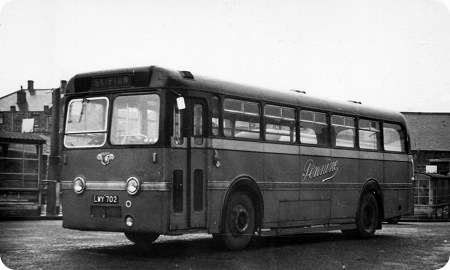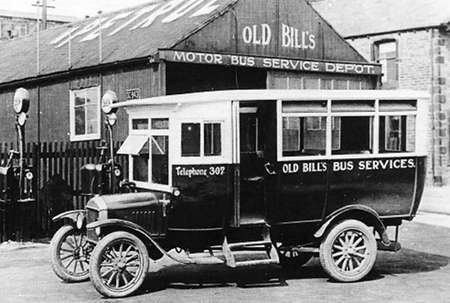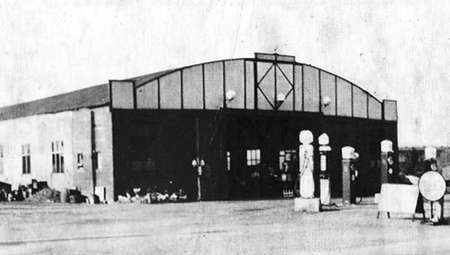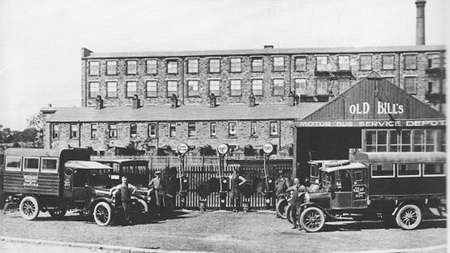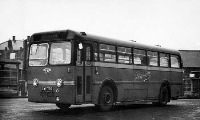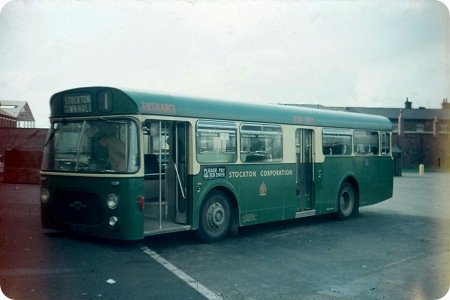East Midland – Leyland Tiger Cub – XRR 540 – R40
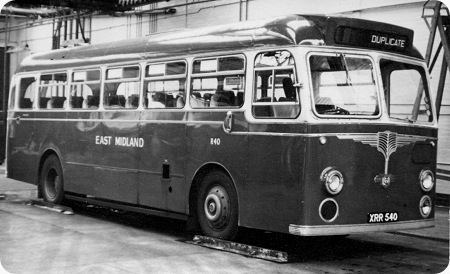
Photograph by ‘unknown’ if you took this photo please go to the copyright page.
East Midland Motor Services
1958
Leyland Tiger Cub PSUC1/2
Willowbrook DP41F
Not an operator I know very much about but on researching this particular vehicle it would appear that it started its life with a fleet number of C40. I have come across a photo of XRR 535 C35 which was in a livery of all Cream with a single coloured band below the window did this vehicle start life as cream coach? I am not sure what their prefix fleet letters stood for ‘C’ For coach ‘D’ for double decker I can guess at but ‘R’ ‘O’ ‘L’ which were for single deckers do not mean much to me. If you know please leave a comment. It would appear that East Midland at one time had a livery of Chrome Yellow for the body, Cream for the lower saloon windows and Chocolate for the upper saloon windows and roof I bet that looked good, has anyone seen a colour shot. The livery at the time that the shot above was taken was Dark Red and Cream but that changed to Dark Green in the early seventies.
I recall the original livery which was very distinctive! It was almost art deco- very thirties- and then went into a sort of drab utility maroon. The green was presumably NBC….?
Joe
I vaguely remember these vehicles from my Sheffield childhood (on the Derbyshire border, towards Chesterfield).
I quite liked the maroon and cream – because I was not then aware of the original livery, which had disappeared by the time I was old enough to be aware of these things. It is possible that this livery was derived from that of Underwoods – the firm which became East Midland under BET control. The original livery adorned a RM in the short time that they plied the roads of Derbyshire and Nottinghamshire.
Over a period of time – in BET times – East Midland became joint owner, along with Yorkshire Traction and North Western, of one of the greatest coach tour operators – nearby Sheffield United Tours.
East Midland became one of my favourite operators – which I used regularly – and I was sad when NBC leaf green replaced the drab maroon. This was especially so when my favourite (J – M) registered RE coaches lost their cream and maroon for NBC corporate livery.
David Oldfield
In 1977, long before the RM already mentioned, East Midland repainted an Alexander bodied Fleetline in the old brown/cream/yellow livery to commemorate their 50th anniversary. One of the 1965 batch, but can’t recall which one. It should also be mentioned that the famous bus photographer Roy Marshall (who once worked in Nottingham and was thus familiar with EMMS’s original livery) later became the General Manager of Burnley & Pendle and adopted the same colour scheme for several of that Lancashire undertaking’s vehicles including some Y-type bodied Leopards and at least one VRT3/ECW double-decker.
Going off at a slight tangent, Roy Marshall also did a stint as the boss of Gelligaer UDC’s fleet and when he moved to East Staffordshire (Burton-on-Trent Corporation as it used to be) he repainted this Midland fleet in Gelligaer’s old livery of green, red, and white – a vast improvement over the gloomy maroon and cream previously used by Burton.
Does anybody know of any further examples where migrating General Managers have ‘taken the livery with them’?
Neville Mercer
Can’t remember which way round it was but Halifax and Glasgow shared a livery due to a demonstrator in one fleet being borrowed by the operator who liked the livery and adopted it themselves.
There is also the apocryphal story of legal action when someone saw the old Bostock’s livery, liked it, adopted it and upset Bostock’s.
I also vaguely remember the Fleetline, now that Neville mentions it.
Trivia: Can anyone explain why, with a head office in Chesterfield, all East Midland buses had Nottinghamshire registrations?
David Oldfield
The 1965 edition of BBF5 says that the R prefix was for 30-foot long dual purpose vehicles, but that can’t be right because it shows all the bus-seated 30-footers with R prefixes as well. L meant long – i.e. 36 feet.
Joining Neville on his tangent for a moment, did Geoffrey Hilditch once set up a coach fleet at Aberdare using Halifax livery? Or did I dream that? The memory does feel very much like a dream . . .
Peter Williamson
According to the Prestige Series book on East Midland (excellent B&W photographs by G H F Atkins; text by John Banks) the old livery was derived from United, who abandoned it in 1930 in favour of red and cream. The company was originally W T Underwood of Clowne, but with strong backing from United (virtually a subsidiary).
As for the alpha-numeric number series, the type-series letter seems to have been allocated in a rather haphazard fashion. Note that only the single-deckers were distinguished in this way. All of the double-deckers were just series D, irrespective of chassis or body manufacturer.
However, unravelling the tangle it seems this is how it went for the single deckers (Are you sitting comfortably? Then I shall begin…) :
G – 50 x ADC 416A (Short Bros.) 1927 – series allocated to EM by United
M – 10 x AEC Reliance (Lowestoft – later ECW) 1929 – series allocated to EM by United
N – 10 x AEC Regal (Short Bros) 1930 (some rebodied 1939 with Leyland bodies taken from 1935 TS7s, i.e. type B)
L – 20 x AEC Regal (Brush) 1931 (of which 3 were coaches, designated LC)
L – ? x AEC Regal 4 (Brush) 1933-34
C – 5 x Leyland KP2 Cub 1934
B – 20 x Leyland TS7 (10 Brush; 10 Leyland) 1935 (4 Brush rebodied 1949 by Willowbrook re-designated type N)
B – 14 x Leyland TS7 (5 Brush; 1 Burlingham coach; 8 Leyland) 1936
E – 30 x Leyland TS7 (ECW dual purpose) 1937 (6 rebodied 1948 by Willowbrook re-designated type N)
F – 11 x Leyland TS7 (ECW bus) 1938
A – 10 x AEC Regal (Weymann) 1946
A – 14 x AEC Regal III (Third-hand ! Leyland bodies) 1947-48 (rebodied 1952 by Willowbrook and re-designated type K)
AC – 2 x AEC Regal III (Windover coach) 1948
H – ? x AEC Regal III (Weymann) 1949
J – ? x AEC Regal III (Willowbrook) 1950
R – All underfloor engine buses from 1952-62 (all Leyland chassis)
C (Second time round) – All underfloor engine coaches and dual-purpose from 1954 onwards.
L – ? x Leyland Leopard buses from 1963 (Willowbrook)
O – ? x Bristol buses from 1969 (ECW)
N (Second time round!) – various re-bodies (see above) also 10 second hand Leyland TS7s purchased from YWD 1949 and subsequently re-bodied by Willowbrook.
Please note that this is not comprehensive, and takes no account of vehicles absorbed through takeover. There were certainly 5 x Bristol L5G (ECW) in 1938 and 2 x Bedford WTB (Duple) in 1939, for which no type letter is quoted.
Stephen Ford
Someone mentioned East Midland having a Fleetline in the old brown livery. This was in fact an Atlantean PD1/2 fleet no D177 registration BNN 177C.
Chesterfield corporation also had Nottingham registrations as well.
Alan Ridge
Chesterfield Corporation had NU and RA registrations – Derbyshire CC.
David Oldfield
R – All underfloor engine buses from 1952-62 (all Leyland chassis)
Some of these were in fact AEC chassis and the last 3 R496 R497 & R498 were AEC chassis and the same bodies as the L400 (400 RRR) series Leylands.
The O series were one batch of AEC Swifts O501 to O510. (NAL 501F to 505F then OAL 506F to 510F) Marshall Bodies,
Bristol RE’s with single doors. O511 to O522. ECW.
Bristol RE’s with single doors. O523 to O532. I think these had Marshall Bodies, I know that they had a strange 3 X 2 arrangement for the rear two rows of seats.
Bristol RE’s with single doors. O533 to O541. Leyland engines and Marshall bodies. I have not heard any news of it, but CRR 537J O537 was preserved, somewhere around Derby.
Bristol RE’s with Dual doors. O542 to O556. ECW bodies. I think O545 was the last red and cream East Midland bus, around 1975/6
Ian Couzens
10/07/12 – 06:44
The question raised about registration numbers being issued in Nottinghamshire. It was from the days of the head office being in Worksop. Why on moving to Chesterfield it was not changed I don’t know. Hope this helps/ Don’t forget Clowne was also head office prior to Worksop.
Ian Bennett
10/07/12 – 09:17
In response to Nevilles question above re migrating General Managers. When Vane-Morland moved from Walsall to Leeds he brought their blue livery with him prior to this the trams and buses were yellow and white or a deep Prusian blue rather than the flatter slate blue that became standard in the thirties.
Chris Hough
26/07/12 – 07:44
The vehicle in the above photograph was taken over the pit at Worksop bus garage on Allen Street Worksop.
Mr Anon
26/10/12 – 07:06
For those youngsters, who were deprived of the EMMS chocolate etc livery, I have appended some links to modern day efforts to replicate the livery.
www.flickr.com/photos/manofyorkshire/
www.flickr.com/photos/
www.flickr.com/photos/guy_arab_uf/
www.flickr.com/photos/deltrems/
John Darwent
12/07/16 – 07:29
Can anyone remember how many routes East Midland had that ran into Pond Street Sheffield in the 70s, there was number 3 from Mansfield, number 46 from Clowne via Killamarsh, number 18 from Eckington, and there was also an EM bus from Gainsbrough.
Big Jim
04/04/17 – 07:15
You’re right about the 3 and 46. There was also the long-established 99 to Chesterfield via Ford and Staveley. Also in the 60s and until 1971 there was the 62/64 to Chesterfield via Eckington. These were joint with Chesterfield and Sheffield JOC.
By 1971 there was also the X53, which was an extended express version of the 3. This ran to Nottingham via Mansfield and was joint with Trent.
The Gainsborough route was the 85 – originally a Sheffield ‘C’ fleet (railways-owned) route but which became a joint Sheffield/East Midland/Lincolnshire route when the British Railways interest in the Sheffield B and C fleets ended.
John May
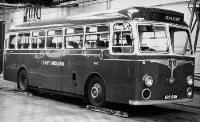 Vehicle reminder shot for this posting
Vehicle reminder shot for this posting
19/07/17 – 11:00
Just been told that the old EMMS bus garage at Retford was demolished in 1992,in the 70s it held a fleet of 25 buses and coaches, Worksop is now the last remaining original depot.
Big Jim
Quick links to the - Comments Page - Contact Page - Home Page
